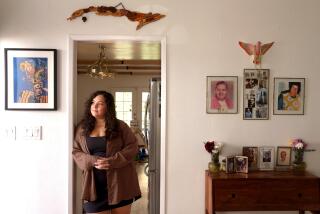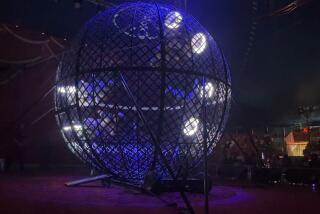The Family That Plays Together . . . : Injuries and Deaths Donât Deter the Dynasties Who Do Movie, TV Stunts * Second of two parts.
When Ron Rondellâs youngest son was killed in a fiery helicopter crash while filming a TV show, the veteran stuntman did what others in the community of stunt performers do when tragedy strikes.
He grieved.
Then he investigated.
And when he was finished, he went back to work.
âThe thought never crossed my mind to quit this business,â Rondell said. âItâs the job I chose. Itâs the thing I do best.â
Rondell, 59, was born to an actor who did his own stunts in silent films, and has been steeped his whole life in the rugged brotherhood of those who stampede horses and crash through windows for the movies.
In the decade since Reid Rondellâs death, this close-knit community has been shaken by the loss of other members, most recently stuntwomen Janet Wilder and Sonja Davis.
The deaths focused attention on safety in Hollywood, and left the stunt community wrestling once again with questions about what went wrong.
Theirs is a world of danger, where the specter of death and injury are ever-present and the individual is ultimately responsible for his or her own safety.
They are intensely physical people who can tell you every broken pelvis, cracked knee or concussion theyâve suffered on any set doubling for any star.
The bonds between them are strong, and the core of the business is dominated by a handful of family dynasties. It is a world that is difficult for outsiders to penetrate, but once inside the rewards are many.
Top stunt performers can earn as much as $350,000 a year doing what many have done since childhood--racing motorcycles, surfing, swimming and diving. Many are high school and college athletes and some are Olympic caliber.
Most say there is a unique challenge--not merely in the jumps and falls themselves, but in figuring out how to survive them. The rush, performers say, is in outwitting the danger--carefully planning safe ways to crash cars at high speed, dangle from helicopters or set oneself on fire.
âItâs living out your wildest fantasy,â said Rondellâs surviving son, R.A. Rondell, himself a stunt man and coordinator.
âHow would you like to drive as fast as you can through downtown Los Angeles with the cops actually waving you on?â R.A. Rondell said. âYou crash the car and itâs not your responsibility. You get out and drive 55 mph home on the freeway.â
To the Epper family, the stunt business was a place for a Swiss immigrant to build an entertainment business empire. Today, four generations of Eppers--14 men, women and children--are working in the business, most of them making more than $100,000 a year.
John Epper, a cavalryman in his native land, came to Hollywood in the 1920s and bought a riding academy on Riverside Drive in Burbank. His students were actors who needed to ride in Westerns, and his friends included Errol Flynn.
Once, when delivering a horse to a movie set, he was asked to help out with a stunt, recalled his daughter, stuntwoman Jeannie Epper, who doubled for actress Lynda Carter on TVâs âWonder Woman.â
âA riding double on that shoot couldnât get the horse he had to jump over an automobile,â Jeannie Epper said. Epper agreed to help out.
âThe horse jumped over the car, and my father was in the business,â Jeannie Epper said.
He went on to double for Gary Cooper, Randolph Scott and Ronald Reagan.
*
Each night around the dinner table, John Epper would regale his wife and six children with stories of that dayâs exploits. And they learned from him. The lessons he imparted--about the tremendous need for preparation if a stunt is to be done safely, how to roll, how to fall--would become second nature. Later, the lessons passed on so casually would save Jeannie Epperâs life.
When filming the 1969 film âMackennaâs Gold,â she was asked to jump a horse off a raft into Oregonâs Rogue River. The horse tipped upside down and Jeannie went underneath him. Her fatherâs words came back to her.
âWhatever you do,â her father had said in one of those daily conversations, âstay on top of the horse.â
Fearing for her life in the rapidly moving water, she forced herself to remain with the horse.
âI reached for the horseâs tail and let him drag me to the surface,â she said. âI feel my father saved my life.â
Being a member of a stunt family has proved a potent way to get into the business. Not only do the children of stunt performers learn their lessons early, they have connections once they grow up.
*
At 22 months, Samantha Epstein already knows how to rappel down a rope while suspended from a pulley. She was just 10 weeks old when her father, stuntman Jon Epstein, strapped her into a roll cage he had constructed inside a trailer attached to his mountain bike.
She knows how to say âPop a wheelie, Daddy,â when theyâre on his motorcycle.
For Halloween last year, her parents dressed her as a bumblebee and sent her squealing down a high wire in the back yard, suspended by a harness attached to her outfit.
This, Jon Epstein said, is how the craft is passed on.
âEverything I do, she does with me,â said Epstein, who regularly doubles for actor Chuck Norris. âOn my dirt bike, she has a little spot between my legs where she hangs on.â
Epstein doesnât intend to push Samantha into the stunt business.
âItâs too dangerous,â he said. âI couldnât sleep at night.â
*
Children occupy a unique place in the stunt world, with much of their growing-up years viewed as a time for apprenticeship. Many start working early, performing single-story falls and riding horses to double for child actors.
Jeff Dashnaw, who has doubled for Steven Seagal and is president of the professional organization Stunts Unlimited, said that his two children have benefited from doing stunt work.
âItâs helped my kids open up as people and have a little more self-confidence,â said Dashnaw, whose 13- and 8-year old sons have worked on âBaywatchâ and an upcoming childrenâs movie. âTheyâre pretty comfortable in any circumstance.â
To avoid danger, dwarfs double for children on the most difficult stunts. State welfare workers are supposed to be on the set whenever children are present.
The business is essentially organized into several fraternal organizations, three for men and two for women. And while thousands of actors are registered with the Screen Actors Guild as stunt performers, only a few hundred work regularly.
The organizations, whose members pay hefty dues and agree to hire each other for stunt jobs, were formed to create a pool of qualified performers for movies and television.
Only the top earners can qualify to join. To enter the Stuntmanâs Assn. of Motion Pictures, for example, an applicant must earn $50,000 per year from doing stunts alone. At Stunts Unlimited, an exclusive group with only 54 people, applicants must earn even more and can only join with the support of 80% of the membership.
To be hired for stunt work in England, performers must be certified instructors in six sports and must then train for five years.
In the U.S., there are no such standards. There are stunt schools, but they are not certified and offer no guarantee of access to the business.
David Ellis, who directed the action sequences in âWaterworld,â said that he got into the business when he was 19, surfing Malibu and chumming around with stuntmen who lived along the beach.
âI started hanging around with these guys, carrying their stunt bags and going with them to the stunt site,â he said. âThey slowly groomed me and got me into the business.â
Soon, he brought his sister Annie into the business as a surfer, working for Ron Rondell on âCharlieâs Angels.â She has since doubled for actress Glenn Close and performed the opening stunt sequence in âSliver,â in which she fell 280 feet at 95 mph, stopped by a descender cable just two feet above a glass ceiling.
The pairâs father, Richard, started working shortly after Annie. Now 68, he has performed stunts in such recent films as âWaterworld,â âClear and Present Dangerâ and âMaverick.â
*
It is a rare stunt performer who cannot recite a litany of broken bones and near misses.
Ron Rondell has had both hips replaced. Annie Ellis bruised both kidneys jumping out of a pickup truck and crashing into corn stalks on the set of âTwister.â
Worse tragedies have paralyzed stunt performers like Heidi Von Belt, who was injured on the set of âCannonball Run,â and led to the deaths of Reid Rondell, Dar Robinson, Janet Wilder, Sonja Davis and others.
But stunt performers live by a creed that pushes them to keep going in the face of injury or even the death of a loved one.
âSometimes a stunt person gets hurt and you donât even know heâs hurt,â said Don Bellisario, a veteran TV action producer. Recently, he said, stuntman Diamond Farnsworth crashed his head into a submarine hatch but kept going for three additional takes on the set of the NBC drama âJAG.â It wasnât until later, Bellisario said, when watching the dailies, that he saw the force with which Farnsworth had struck the hatch and the blood that oozed from his scalp.
Two people have died on Bellisarioâs sets, both in helicopter crashes. Cameraman Robert Vanderkar was killed on the set of âMagnum P.I.,â and Reid Rondell, the 22-year-old son of stuntman Ron Rondell, died while doubling for actor Jan-Michael Vincent in âAirwolf.â
Reidâs death, his father said, provided a searing reminder that death can intrude even in the face of the most careful precautions.
With each tragedy, stunt performers quietly talk among themselves, looking for clues as to what went wrong. It is life or death information for the entire community.
The Rondells quickly mounted their own investigation. On the day of the accident in 1985, Reidâs brother R.A. drove out to the crash site and personally interviewed witnesses.
âYou just gather it up and deal with the grief and go on with it,â said Ron Rondell. âAnd try to make sure it never happens again.â


